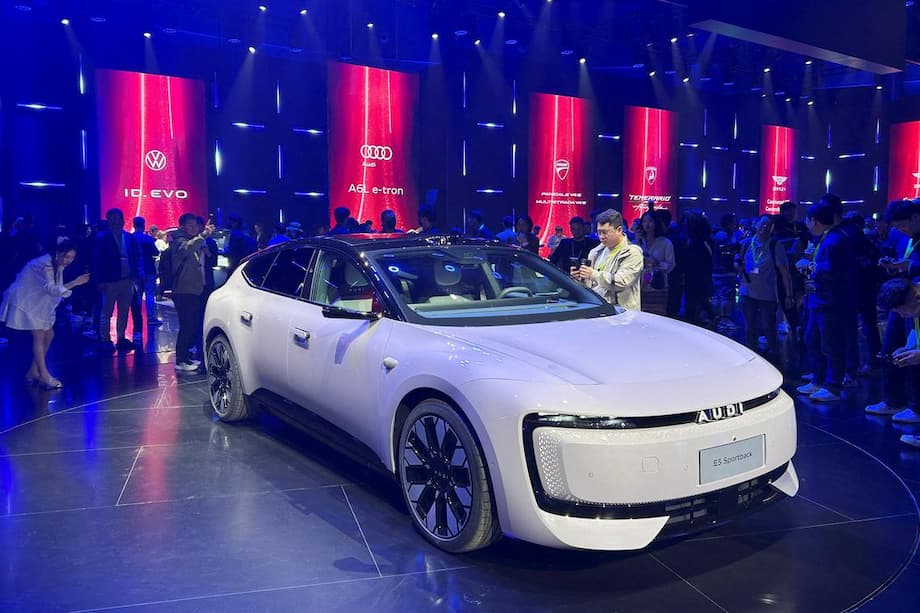Inside the race to put China inside the next wave of EVs
When senior Audi managers first studied the Zeekr 001, a long range electric fastback that paired European styling with Chinese software and battery know how, it felt like a turning point. Within 18 months, Audi developed the E5 Sportback for China using core components from local partner SAIC, from batteries and electric motors to infotainment and driver assistance. That speed is now the benchmark. Global carmakers from Volkswagen to Toyota, Renault and Ford are seeking Chinese platforms, electronics and software to bring fresh electric models to market faster and at lower cost. Chinese suppliers and brands see an opening too. Intense competition at home and trade barriers abroad are pushing them to license technology, sell complete chassis and electronics “in a box,” and strike factory deals overseas.
- Inside the race to put China inside the next wave of EVs
- How China built the EV edge
- Licensing deals and platform sharing accelerate launches
- Battery tech and the supply chain behind the new designs
- Trade barriers redraw the map
- What legacy carmakers gain and risk
- Where Chinese EVs and tech are spreading
- What it means for consumers and climate
- What to Know
This is more than sourcing parts. The center of gravity in electric vehicle design, software and batteries has shifted toward China after two decades of policy support, investment and scale. The result is changing what cars look like, how they are engineered and how brands launch them. It is also colliding with a rising tide of tariffs and export controls, which are reshaping where vehicles, batteries and code are built. The new dynamic blends collaboration and rivalry, with both sides trying to capture value while protecting their crown jewels.
How China built the EV edge
China did not stumble into leadership. National and local policies dating back to the early 2000s prioritized electric mobility, funding research, pilot fleets and public procurement. Subsidies and tax breaks lowered prices for buyers and gave domestic firms runway to improve products. Cities accelerated demand by waiving license plate restrictions for electric cars and electrifying buses and taxis. As a result, China has been the largest EV market for years. In 2023, global electric car sales neared 14 million, and China registered about 8.1 million of them, far ahead of Europe and the United States. Competition inside China is relentless, and that pressure helped speed up innovation in batteries, software and manufacturing.
Policies, scale and batteries
Scale came with supply chain depth. Battery champions refined lithium iron phosphate (LFP) cells that are cheaper and more durable than many nickel based chemistries. Factories optimized pack design and thermal management, raising energy density and safety while cutting cost. China also built dominance in refining key minerals and in battery component production, creating a more predictable pipeline for domestic makers. Tesla’s Shanghai plant benefited from the same environment, showing how global firms can thrive inside China’s EV ecosystem. Strong consumer interest in connected features and frequent software updates further cemented a software first approach to vehicles.
Software first design, faster launches
A hallmark of China’s lead is a modular mindset. Automakers and suppliers design core underpinnings, sometimes called skateboard chassis, with standardized battery packs, electric motors, power electronics and a centralized electronic architecture. This allows rapid iteration of body styles and trims on top of a stable core. Software defines many features that once relied on hardware, from driver assistance to cockpit design. Over the air updates let cars improve after purchase. For legacy carmakers with complex internal structures, importing a mature Chinese platform or electronics layout can shortcut years of development.
Licensing deals and platform sharing accelerate launches
The list of cross border tie ups is growing. Audi’s China focused E5 Sportback rides on SAIC technology. Volkswagen is co developing China dedicated models with Xpeng and is evaluating Xpeng’s electronics and software layout. Toyota has worked with GAC for China specific products. Renault’s budget Dacia Spring for Europe sits on a platform from Dongfeng, and the next Twingo is being engineered out of Shanghai with support from a Chinese EV engineering firm. Ford has been scouting for a Chinese partner to supply an EV platform. Leapmotor struck a global alliance with Stellantis that includes technology licensing and export of complete vehicles.
Stefan Poetzl, who leads sales and marketing at SAIC Audi, described the jolt that set this wave in motion.
“The Zeekr 001 back then shocked quite everyone. We needed to do something about it.”
Industry consultants say the approach can be a smart trade. Western brands buy time and reduce risk. Chinese firms open a fresh revenue stream while home market margins are squeezed by a price war. The result is a flurry of white label offerings that include chassis, battery integration, powertrain software and advanced driver assistance systems (ADAS). Using a ready made package can save billions of dollars and compress a typical development cycle from four or five years to closer to two.
The Intel Inside playbook, applied to cars
Many executives liken the shift to the 1990s period when a single chip brand quietly powered many PCs. Here, the invisible “inside” is a mature EV platform and electronics backbone. Volkswagen’s partnership with Xpeng is a case in point. The aim is to graft a nimble, software centric architecture onto models for China, then consider wider use. Yale Zhang, managing director at consultancy AutoForesight, said the strategy could travel.
“If it works in China, Volkswagen could apply the strategy globally.”
Analysts add that cars based on technology proven in China’s intense market tend to be de risked on quality and functionality. This helps legacy brands deliver credible EVs faster and with fewer surprises, while they rebuild internal software and battery capabilities.
Battery tech and the supply chain behind the new designs
Batteries remain the biggest line item in an EV bill of materials and a major lever of range, safety and price. Chinese companies have pushed LFP chemistry into the mainstream, led by innovations like blade style packs that pack cells more efficiently. Lithium manganese iron phosphate (LMFP) is also moving from labs into production. In parallel, improvements in battery management software, cooling and structural integration have boosted performance. This progress supports more affordable EVs without sacrificing the driving range many buyers want.
Suppliers are now selling more than cells. They package entire rolling platforms that include battery trays, suspension mounting points and high voltage systems. CATL’s new Bedrock chassis, shown recently in Europe, is designed to let carmakers vary body styles while standardizing the heavy engineering underneath. Hu Guoliang, an executive at CATL, framed the pitch in consumer terms.
“The chassis will allow consumers to decide what an EV looks like, rather than having giant carmakers decide what to sell.”
China has also tightened control over sensitive know how. New rules require licenses for transferring several key battery manufacturing technologies abroad, including processes linked to cathode materials and lithium extraction. The intent is to protect a hard won lead and to steer foreign collaboration toward controlled avenues such as onshore plants or licensing agreements. That intersects with policies in Europe and North America that aim to localize battery production. One template is technology licensing without equity control, such as Chinese battery know how licensed to a plant operated by a Western partner.
Trade barriers redraw the map
Governments are moving quickly to manage a surge in Chinese EV exports and to defend domestic industry plans. The United States raised tariffs on Chinese electric cars to 100 percent, a level that keeps them out of the market and could slow adoption in the near term. The European Union announced provisional anti subsidy duties of up to 37.6 percent on Chinese EVs while it finalizes an investigation. Canada lifted its tariff on Chinese EVs to 100 percent. Mexico has proposed a 50 percent tariff on autos from countries without a free trade deal, a step that would fall heavily on Chinese made vehicles and could also catch models routed through Mexico by brands without local plants.
China has pushed back within trade forums and with targeted retaliatory moves, and it has signaled that export controls on critical minerals and battery processes are on the table. Companies are responding by shifting assembly to third countries, accelerating European factory projects, or relying on licensing to separate software and platform transfers from final assembly. Europe is courting battery and vehicle investments to keep value within the bloc. Hungary has become a focal point, attracting major battery plants and new vehicle projects tied to Chinese partners.
Inside China, overcapacity and a fierce price war are driving the export push. Only a fraction of automakers run plants near efficient utilization, so the strongest players are sending cars abroad in growing numbers. BYD’s tight vertical integration, from cells to power electronics, gives it room to cut sticker prices while staying profitable. Tesla’s Shanghai operation has also run at very high utilization, reinforcing how scale and process discipline translate into cost advantage. The export pivot will not save every brand, yet it is already reshaping showrooms from Southeast Asia to the Middle East and parts of Europe.
What legacy carmakers gain and risk
The appeal of Chinese EV platforms is speed and certainty. A proven skateboard and electronics layout can underpin several models. That frees up resources for styling, tuning, user interface and brand specific features. It also unlocks modern electronic architectures that centralize computing and simplify software updates. For many incumbents, this is a bridge to an era where cars are designed around software and power electronics, not around an engine and transmission.
There is a trade off. If many brands buy the same core, differentiation can narrow. Partner dependence can also limit control over costs, roadmaps and data. Former Aston Martin chief executive Andy Palmer cautioned that outsourcing too much can erode a brand’s identity and strategic depth.
“In the long term, you’re screwed because you’re just a retailer.”
Keeping identity while buying speed
Some automakers are trying a hybrid approach. They take a partner’s platform, then integrate their own human machine interface, safety stacks and chassis tuning to keep a familiar feel. Others co develop electronics layers so that software, data handling and cloud services remain in house. The goal is to capture time to market gains without becoming interchangeable. This is also why some partnerships start in China, where speed pressures are highest, with an option to adapt the model elsewhere if it proves successful.
Where Chinese EVs and tech are spreading
Electric cars made up around 18 percent of global sales in 2023, and the number is still rising. Sales remain concentrated in China, Europe and the United States, but growth is picking up in Southeast Asia and Latin America. Consumers consistently cite range, charging access and price as top concerns. The desired real world range clusters around 500 kilometers, and many buyers will not pay a premium over similar gasoline models. That is where Chinese cost structures matter. LFP packs, vertical integration and efficient factories allow compelling prices without stripping features, which in turn pressures rivals to cut costs or to partner.
Trade policy is altering routes to market. Chinese EVs are absent from the United States for now because of tariffs, so companies are leaning into Europe, the Middle East, Australia and parts of Asia and South America. Mexico has been a bright spot for growth, though proposed tariffs could change the calculus if enacted by Congress. There is also a wave of factory planning in Europe to blunt tariff exposure. Meanwhile, Chinese technology increasingly arrives inside Western nameplates. Joint programs between European or US brands and Chinese partners bring mature battery systems, driver assistance and infotainment into cars wearing familiar badges.
At home, China’s price war continues to reshape the field. Leaders like BYD have reduced prices aggressively, helped by in house production of batteries and chips. New entrants have sprung up, and some technology firms are moving into cars, but many smaller players face consolidation pressure. The intensity of domestic competition is one reason legacy brands see upside in licensing Chinese technology. It buys them not only speed but also access to systems that have already been stress tested in a demanding market.
What it means for consumers and climate
For buyers, the convergence has clear effects. More models are arriving faster, with better range for the money, larger screens, smarter voice control and more capable ADAS. Over the air updates can fix bugs and add features without a dealer visit. Small, efficient models are getting fresh attention as some countries explore incentives that favor lighter vehicles. A growing used EV market will widen access further as early models filter down into second owners.
For climate goals, the picture is mixed. Affordable EVs accelerate adoption and can cut emissions if powered by cleaner grids. Tariffs that keep cheaper models out of large markets can slow the shift, at least in the near term, even if they support domestic industrial plans. Fragmented supply chains can also add cost and delay. Policymakers are trying to balance energy security, industrial strategy and consumer uptake. Battery recycling and diversified mineral supply are moving up the agenda to reduce risk and environmental impact. The next phase will test whether collaboration, licensing and targeted local production can keep prices in check while meeting political constraints.
What to Know
- Global automakers are adopting Chinese EV platforms, electronics and software to cut development time and cost.
- Audi’s E5 Sportback for China was engineered in 18 months using SAIC technology, signaling a new pace for legacy brands.
- Volkswagen is co developing models with Xpeng, and Renault has used Chinese platforms for Dacia Spring and the next Twingo.
- China’s lead rests on policy support, scale and battery innovation, especially in LFP and pack integration.
- New Chinese export controls require licenses to transfer several battery manufacturing technologies abroad.
- Tariffs are rising: the United States at 100 percent on Chinese EVs, the European Union with provisional anti subsidy duties, and Canada at 100 percent.
- Mexico has proposed a 50 percent tariff on autos from non FTA countries, which would affect Chinese made vehicles if passed.
- Chinese firms are responding with overseas factories, licensing deals and exports to markets with fewer barriers.
- Domestic overcapacity and a price war in China are driving export growth and consolidation among brands.
- Consumers should see more EV choice and value, though tariffs may slow adoption in some regions in the short term.




